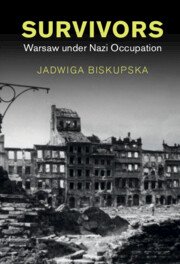Book contents
- Survivors
- Maps
- Studies in the Social and Cultural History of Modern Warfare
- Survivors
- Copyright page
- Dedication
- Contents
- Figures
- Acknowledgments
- Introduction
- 1 Warsaw Besieged
- 2 The Killing Years
- 3 Pawiak Prison
- 4 The Warsaw Ghetto
- 5 Information Wars
- 6 School of Hard Knocks
- 7 Matters of Faith
- 8 Spoiling for a Fight
- 9 Home Army on the Offensive
- Conclusion
- Bibliography
- Index
1 - Warsaw Besieged
September 1939
Published online by Cambridge University Press: 27 January 2022
- Survivors
- Maps
- Studies in the Social and Cultural History of Modern Warfare
- Survivors
- Copyright page
- Dedication
- Contents
- Figures
- Acknowledgments
- Introduction
- 1 Warsaw Besieged
- 2 The Killing Years
- 3 Pawiak Prison
- 4 The Warsaw Ghetto
- 5 Information Wars
- 6 School of Hard Knocks
- 7 Matters of Faith
- 8 Spoiling for a Fight
- 9 Home Army on the Offensive
- Conclusion
- Bibliography
- Index
Summary
Chapter 1, “Warsaw Besieged: September 1939,” describes the September 1939 siege of Warsaw during Case White (the September Campaign or Polish Defensive War) by the German Wehrmacht and Nazi SS personnel and the city’s eventual capitulation. The first of four chapters on how Nazi Germany dismantled the Polish state and nation for long-term occupation by targeting the Warsaw intelligentsia, the description of the siege frames the project. The military invasion revealed German brutality and weak Polish military performance, and provoked a Polish government evacuation crisis. The evacuation created chaos, ruptured Poles’ faith in their government, and triggered the creation of a Polish government-in-exile in western Europe far from occupied Warsaw. The people of Warsaw, led by Mayor Stefan Starzyński, coordinated military-civilian cooperative defense efforts, setting the tone for elite behavior during the coming occupation. This chapter argues that the siege-time cooperation was the foundational experience of the capital’s intelligentsia, and framed responses to the persecutions of the coming occupation.
Keywords
- Type
- Chapter
- Information
- SurvivorsWarsaw under Nazi Occupation, pp. 22 - 47Publisher: Cambridge University PressPrint publication year: 2022



